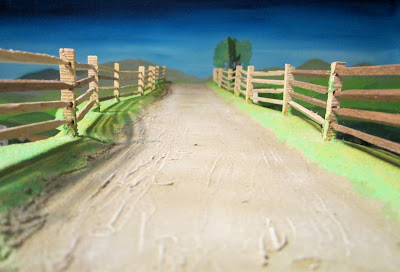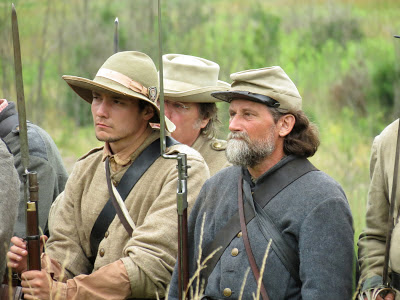Perhaps the most iconic structure of Gettysburg is that of the Lutheran Theological Seminary, the cupola of which is part of the American mythos as the place from which John Buford sized up his situation on the afternoon prior to the Battle of Gettysburg. It is a beautiful building and has only recently, and just in time for the sesquicentennial, opened to the public as a museum interpreting the building's role in the battle, the aftermath, emancipation, and spiritual life during the Civil War era. It does an exceptional job of telling those stories
Save for the clutter of the parking lot the building appears much as it did during the battle.
In contrast to the structure the signage is modern though effective.
Upon entering the building, one pays admission (more later), gets oriented by very pleasant visitor use assistants, and takes the elevator to the fourth floor where the visit begins.
The former common areas of this building provide open space, visitor seating, and well-done interpretive videos.
The common area of each floor branches off into separate galleries tied together by the central hallway.
The fourth floor concerns itself with the battle, and that is examined through a modest, though very fine, collection of artifacts as well as effective murals throughout the museum.
Admission to the museum is $9.00 Which seems steep considering that the Gettysburg Foundation/National Park admission for the visitor centere museum is$12.50 which includes the museum, the film, and the cyclorama.
If you wish to climb the steps to the cupola however...
It will cost you a whopping twenty dollars extra!
Neither my trick knee or pocket book was up to the challenge.
A visitor looking off into the distance for that double saw-buck that just sailed away.
Ouch!
The third floor of the Museum interprets the Seminary building as a Civil War hospital, serving the wounded immediately after the battle, and this it does particularly well.
The vignettes are quite compelling with excellent recorded interpretation provided
at the push of a button.
The mannequins are particularly convincing and well-sculpted
In a somewhat misguided effort to, I assume, spare children the historical images of the battlefield dead, these hopper-like enclosures surround the monitors displaying period photographs of the dead and maimed, however...
for people in wheelchairs, or the more diminutive visitor (note tip-toes) the experience was significantly diminished or even unavailable.
And oddly, children are not shielded from graphic vignettes of mangled limbs being sawed off. That must have been an interesting exhibit planning meeting.
The level of detail in the vignettes is superb...
right down to the details of bloody fingerprints on the door jamb.
On the second floor are interpretive moments focusing on faith and social justice...
including the role of African-Americans in the war...
as well as significant religious movements of the era.
Both are done particularly well.
The "hands on" experiences include "lift the rifle" and "lift the pack", or in this instance,
lift the hat.
There's also lift the bucket of clear resin, which seems considerably heavier than a bucket of water. As "hands on" experiences these left much to be desired.
One of the coolest things about making this venerable old building accessible to the public is to be able to soak in some of the details of the building including...
niches,
newel posts,
hearth grates,
and an elegant entryway; all very beautiful.
There was one interactive which I found particularly satisfying and meaningful, it allowed visitors, using provided pencils and post-it notes, to articulate their hopes for a more perfect Union.
World peace and same-sex marriage were the dominant themes...
with equally worthy wishes as well.
As far as visitor amenities there is an elevator, spacious and clean bathrooms, and, as all modern museums do, the last stop is...
the gift shop.
I think this museum is a new, and very well done, addition to the overall experience for the Gettysburg visitor. I enthusiastically recommend it for your next trip to the Keystone state.
From just north of Boonsboro,
Mannie






























































